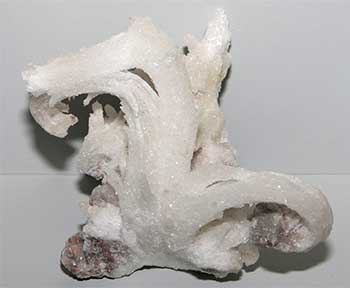 |
| Gypsum - CaSO4.2H2O. |
Gypsum belongs to a group of minerals called the sulfates, and is the most common of the approximately 150 sulfate minerals. Sulfates are compounds of one or more metals with oxygen and sulfur. The oxygen and sulfur join together to form the sulfate ion, SO4-2. Technically, gypsum is hydrous calcium sulfate because it has water in its crystal structure, CaSO4.2H2O.
A secondary, and minor source, of raw calcium sulfate is the mineral anhydrite. Anhydrite is chemically very much like gypsum, but lacks the water molecule in its crystal structure. Its chemical formula is CaSO4.
Gypsum is very soft at 2 on Moh’s hardness scale. It is so soft that a fingernail can easily scratch it. Gypsum crystals can be a number of attractive colors, ranging from completely colorless to tan and even green. Sedimentary gypsum is nearly always white or gray in color.
Sedimentary gypsum is the gypsum that is mined as a commodity.
Name
The mineral name gypsum is so old that it is not known who originated its use. It was derived from the Greek word gypsos which means plaster. Originally it referred to the form of gypsum which has been heated to a high temperature to drive off the water in its crystal structure; this is called calcined gypsum. This is called Plaster of Paris.
Sources
In the United States, gypsum is mined in about 19 states. The states producing the most gypsum are Oklahoma, Iowa, Nevada, Texas, and California. Together, these states account for about two-thirds of the United States’ annual production of gypsum. Over 30 million tons of gypsum is consumed in the United States annually. Canada, Mexico and Spain are other significant producers of raw gypsum. In all, more than 90 countries produce gypsum.
Uses
The most significant use for gypsum is for wallboard and plaster products. All modern homes in North America and other developed countries use a great deal of wallboard for interior walls. The United States is the world’s leading consumer of wallboard at over 30 billion square feet per year. Some gypsum is used to make Portland cement, and some is used in agricultural applications. A small amount of very pure gypsum is used in glass making and other specialized industrial applications.
Substitutes and Alternative Sources
Gypsum is a by-product of some industrial processes. Although mined gypsum will remain the primary source of this commodity for decades to come, about one-fourth of current gypsum production is provided as a by-product of some industrial processes. There is presently no substitute for gypsum in the production of Portland cement.